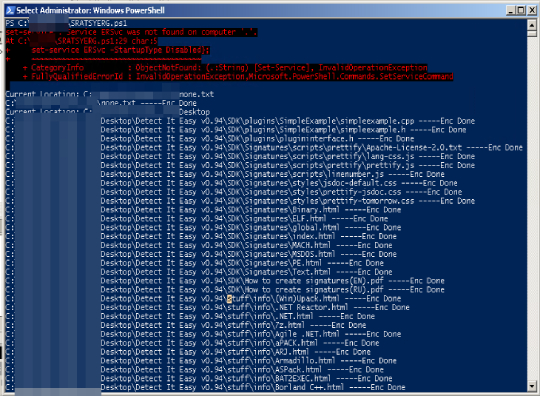Ransom.PS1.SRATSYERG.THLOGBC
HEUR:Trojan-Ransom.Win32.Generic (KASPERSKY)
Windows

Threat Type:
Ransomware
Destructiveness:
No
Encrypted:
No
In the wild::
Yes
OVERVIEW
It arrives on a system as a file dropped by other malware or as a file downloaded unknowingly by users when visiting malicious sites.
TECHNICAL DETAILS
Detalles de entrada
It arrives on a system as a file dropped by other malware or as a file downloaded unknowingly by users when visiting malicious sites.
Instalación
Infiltra los archivos siguientes:
- %User Profile%\none.txt → encrypted afterwards and renamed as none.txt.greystars@protonmail
- %Temp%\{Random 1} → contains the certificate used for encryption (deleted afterwards)
- %Temp%\{Random 2} → contains the AES Key and IV used for encryption (deleted afterwards)
(Nota: %User Profile% es la carpeta de perfil del usuario activo, que en el caso de Windows 98 y ME suele estar en C:\Windows\Profiles\{nombre de usuario}, en el caso de Windows NT en C:\WINNT\Profiles\{nombre de usuario}, en el caso de Windows 2000(32-bit), XP y Server 2003(32-bit) en C:\Documents and Settings\{nombre de usuario} y en el caso de Windows Vista, 7, 8, 8.1, 2008(64-bit), 2012(64-bit) y 10(64-bit) en C:\Users\{nombre de usuario}).
. %Temp% es la carpeta de archivos temporales de Windows, que suele estar en C:\Windows\Temp o C:\WINNT\Temp).)Agrega los procesos siguientes:
- %System%\bcdedit.exe -noninteractive /set -encodedCommand ZABlAGYAYQB1AGwAdAA= bootstatuspolicy ignoreallfailures -inputFormat xml -outputFormat xml
- %System%\bcdedit.exe -noninteractive /set -encodedCommand ZABlAGYAYQB1AGwAdAA= recoveryenabled No -inputFormat xml -outputFormat xml
- %System%\bcdedit.exe /set bootstatuspolicy ignoreallfailures
- %System%\bcdedit.exe /set recoveryenabled No
- %System%\taskkill.exe /f /im agntsvc.exe /im isqlplussvc.exe /im ncsvc.exe /im msftesql.exe /im sqlagent.exe /im sqlbrowser.exe /im sqlservr.exe /im sqlserver.exe /im sqlwriter.exe /im oracle.exe /im ocssd.exe /im dbsnmp.exe /im synctime.exe
- %System%\vssadmin.exe Delete Shadows /All /Quiet
- %System%\wbadmin.exe DELETE SYSTEMSTATEBACKUP -keepVersions:0
- %System%\Wbem\WMIC.exe SHADOWCOPY DELETE
- %System%\wevutil.exe cl "windows powershell"
- %System%\wevutil.exe cl security
- %System%\wevutil.exe cl system
(Nota: %System% es la carpeta del sistema de Windows, que en el caso de Windows 98 y ME suele estar en C:\Windows\System, en el caso de Windows NT y 2000 en C:\WINNT\System32 y en el caso de Windows 2000(32-bit), XP, Server 2003(32-bit), Vista, 7, 8, 8.1, 2008(64-bit), 2012(64bit) y 10(64-bit) en C:\Windows\System32).
)Otras modificaciones del sistema
Agrega las siguientes entradas de registro:
HKEY_LOCAL_MACHINE\SOFTWARE\Microsoft\
Windows\CurrentVersion\SystemRestore
DisableSR = 1
HKEY_LOCAL_MACHINE\SOFTWARE\Policies\
Microsoft\Windows Defender
DisableAntiSpyware = 1
Elimina las siguientes claves de registro:
HKEY_LOCAL_MACHINE\SOFTWARE\Microsoft\
Windows\CurrentVersion\Explorer\
ShellServiceObjects\{FD6905CE-952F-41F1-9A6F-135D9C6622CC}
HKEY_LOCAL_MACHINE\SOFTWARE\Microsoft\
Windows\CurrentVersion\Run
WindowsDefender =
HKEY_LOCAL_MACHINE\SOFTWARE\Microsoft\
Windows\CurrentVersion\Explorer\
StartupApproved\Run
WindowsDefender =
HKEY_CURRENT_USER\SOFTWARE\Microsoft\
Windows\CurrentVersion\Run
WindowsDefender =
Finalización del proceso
Finaliza los procesos siguientes si detecta que se ejecutan en la memoria del sistema afectado:
- agntsvc.exe
- dbeng50.exe
- dbsnmp.exe
- encsvc.exe
- firefoxconfig.exe
- isqlplussvc.exe
- isqlplussvc.exe
- msftesql.exe
- mydesktopqos.exe
- mydesktopservice.exe
- mysqld-nt.exe
- mysqld-opt.exe
- mysqld.exe
- ncsvc.exe
- ocautoupds.exe
- ocomm.exe
- ocssd.exe
- oracle.exe
- oracle.exe
- sqbcoreservice.exe
- sql.exe
- sqlagent.exe
- sqlbrowser.exe
- sqlite.exe
- sqlserver.exe
- sqlservr.exe
- sqlwriter.exe
- synctime.exe;
- tbirdconfig.exe
- xfssvccon.exe
Otros detalles
Hace lo siguiente:
- It terminates the following services:
- BITS
- ERSvc
- vss
- WerSvc
- WinDefend
- Wscsvc
- Wuauserv
- It terminates itself if %User Profile%\none.txt.greystars@protonmail already exists.
- It encrypts files on fixed drives except in C: wherein it encrypts only the following:
- %User Profile%\Desktop
- %User Profile%\Documents
- It clears the Windows PowerShell, Security, and System event logs.
- It force restart the system after encrypting files.
- It displays log activity through console.

SOLUTION
Step 1
Los usuarios de Windows ME y XP, antes de llevar a cabo cualquier exploración, deben comprobar que tienen desactivada la opción Restaurar sistema para permitir la exploración completa del equipo.
Step 2
Note that not all files, folders, and registry keys and entries are installed on your computer during this malware's/spyware's/grayware's execution. This may be due to incomplete installation or other operating system conditions. If you do not find the same files/folders/registry information, please proceed to the next step.
Step 3
Eliminar este valor del Registro
Importante: si modifica el Registro de Windows incorrectamente, podría hacer que el sistema funcione mal de manera irreversible. Lleve a cabo este paso solo si sabe cómo hacerlo o si puede contar con ayuda de su administrador del sistema. De lo contrario, lea este artículo de Microsoft antes de modificar el Registro del equipo.
- In HKEY_LOCAL_MACHINE\SOFTWARE\Microsoft\Windows\CurrentVersion\SystemRestore
- DisableSR
- DisableSR
- In HKEY_LOCAL_MACHINE\SOFTWARE\Policies\Microsoft\Windows Defender
- DisableAntiSpyware
- DisableAntiSpyware
Step 4
Restore these deleted registry keys/values from backup
*Note: Only Microsoft-related keys/values will be restored. If the malware/grayware also deleted registry keys/values related to programs that are not from Microsoft, please reinstall those programs on your computer.
- In HKEY_LOCAL_MACHINE\SOFTWARE\Microsoft\Windows\CurrentVersion\Explorer\ShellServiceObjects
- {FD6905CE-952F-41F1-9A6F-135D9C6622CC}
- {FD6905CE-952F-41F1-9A6F-135D9C6622CC}
- In HKEY_LOCAL_MACHINE\SOFTWARE\Microsoft\Windows\CurrentVersion\Run
- WindowsDefender
- WindowsDefender
- In HKEY_LOCAL_MACHINE\SOFTWARE\Microsoft\Windows\CurrentVersion\Explorer\StartupApproved\Run
- WindowsDefender
- WindowsDefender
- In HKEY_CURRENT_USER\SOFTWARE\Microsoft\Windows\CurrentVersion\Run
- WindowsDefender
- WindowsDefender
Step 5
Buscar y eliminar estos archivos
- %User Profile%\none.txt.greystars@protonmail
- %Temp%\{Random 1}
- %Temp%\{Random 2}
- {Encrypted Path}\How-To-Recover-Your-Files.html
- %User Profile%\none.txt.greystars@protonmail
- %Temp%\{Random 1}
- %Temp%\{Random 2}
- {Encrypted Path}\How-To-Recover-Your-Files.html
Step 6
Explorar el equipo con su producto de Trend Micro para eliminar los archivos detectados como Ransom.PS1.SRATSYERG.THLOGBC En caso de que el producto de Trend Micro ya haya limpiado, eliminado o puesto en cuarentena los archivos detectados, no serán necesarios más pasos. Puede optar simplemente por eliminar los archivos en cuarentena. Consulte esta página de Base de conocimientos para obtener más información.
Step 7
Restore encrypted files from backup.
Did this description help? Tell us how we did.

